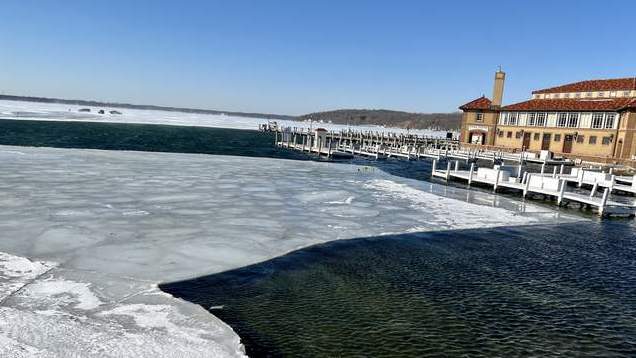Front Page
ICY DEATH HOVERS OVER THE LAKE
The Ice on top of Geneva Lake. In places, according to the guides and fishermen, the Geneva Shore Report inquires of, the ice thickness runs to almost a foot. However, in many places, the ice is less than four inches thick. Around the edges of the bubbled water at the piers of the Lake Geneva Riviera Complex, the ice is four inches thick almost all the way from the open water (which is growing larger in size every day) to a hundred and fifty yards close to the pier location. The pier has been, of course, removed for the winter as the location has no bubblers. This is the critical time to be oh so careful out there on the ice.
Remember, almost all ice break-through rescues are not rescues at all. They are body recoveries. Unless someone, non-trained and quite likely badly equipped, is nearby if you go through the ice, then emergency services will not reach you in time to save your life. If you are in a vehicle, the sinking can be even worse, as getting out of the sinking vehicle can take very vital and valuable time. Twenty percent of the people who go through the ice into freezing water die in the first two minutes (of cold shock). The next forty percent die of cold-induced movement incapacitation. Drowning kills the next twenty percent (mostly due to the shock and incapacitation). The final group, the smallest, is the one most people think is the real reason for people not making it if they plunge in. That cause is called hypothermia.
Hypothermia presupposes some ability to stay above the surface of the water (like a life jacket). A healthy human can last about half an hour bathed fully in ice water (thirty-three degrees, on average) in a life jacket, but most people out on the ice don’t wear them.
Do not drive out on the ice in any vehicle now. Do not go out there without a life jacket, as strange as that seems to be. It might look strange to others to be seen out on the ice with a life jacket on, but it would be a real-life saver if the ice broke and the worst happened. Don’t be the first or only fatality this year out on that ice.
For emergency personnel and equipment to reach the scene of a potentially fatal plunge through Geneva Lake Ice, can take anywhere from a bare minimum of twenty minutes (and that’s super-fast considering rescue forces are not standing by at fire or police stations waiting for such an event to occur at any moment) or up to more than half an hour if the plunge takes place way out across the lake’s surface. Ice fishermen generally carry ice picks in order to stab and fight a way back up onto nearby ice, but ice picks are no help if one has lost the ability to hold them. The last fatality on the lake was a fisherman who went in near Town of Linn pier. He had two ice picks and did manage to use them, only to discover that nowhere around him was the ice thick enough to allow him to pull himself back up.
Geneva Lake is never totally safe for driving on, no matter what the vehicle. The lake is spring-fed and there is no way to accurately calculate where the spring water, coming up from fissures along the bottom that run the length and breadth of the waters, will rise and melt the undersides of parts of the ice. Now that the real low temperatures of winter appear to be passing, it is time to get vehicles and equipment off the surface of the ice and begin restricting fishing, walking, or merely strolling across the surface.









